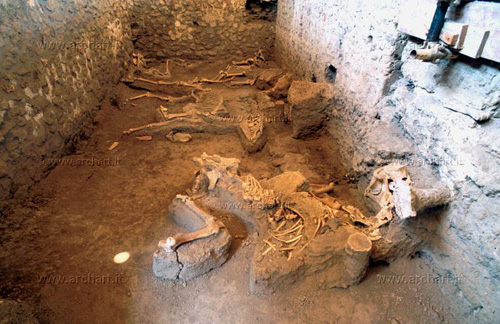Ever since the remains of a seemingly unknown breed of horse were excavated at the ancient city of Pompeii, scientists have been puzzled over this find. Now, the riddle is solved: what was thought to be a horse, is actually an ass.
After DNA tests were done on a skeleton discovered amongst the ruins of an ancient Roman house in Pompeii in 2004, Italian scientists concluded they had discovered a new breed. Yet, after taking a closer look at the data, researchers from Cambridge and Munster say that in this study, a mistake was made. Their arguments – the donkey DNA was contaminated with horse DNA, leading to an artificial hybrid DNA being formed – are published in a letter to the editor of the Journal of of Cellular Biochemistry.
An ancient equine from Pompeii?For the original study, five skeletons from the family of Equidae – which includes horses, donkeys and zebras – were analyzed. These skeletons had been unearthed at the ancient Roman city of Pompeii – from the stables of the "Casa dei Casti Amanti", the House of the Chaste Lovers. They were found well preserved, covered by the layer of volcanic ash that buried Pompeii and nearby Herculaneum when the Vesuvius erupted in 79 AD.
The mistake could have happened as early as during the excavation – maybe DNA from one skeleton was transferred to another. It is also possible the error happened because of carelessness in the laboratory, or only later when the data was analyzed on the computer.
The research team that conducted the original study looked at the 2,000-year-old mitochondrial DNA of the horses – DNA that does not belong to the nucleus, but to the "energy plants" (mitochondria) of cells. Four of the DNA types were easily assigned, they were consistent with typical mitochondrial horse genome. The fifth horse, however, seemed to be a horse-like indeed, but it possessed unknown DNA. The scientists concluded this was a previously unknown – and probably extinct – horse breed (Genetic characterization of Pompeii and Herculaneum Equidae buried by Vesuvius in 79 AD, abstract here).
It's an assNow, Susan Gurney, PhD student at the Institute of Animal Physiology of the University of Münster, and member of the Institute of Forensic Genetics and the University of Cambridge, reexamined the data of this study, and concluded an error was made.
Gurney says it is obvious that the mitochondrial DNA of a horse came in contact with the mitochondrial DNA of the donkey, forming the hybrid DNA – which 'came from an unknown breed'.
She showed that the first 177 blocks (nucleotides) of the DNA strand match with the nucleotide sequence of donkey DNA. The other 193 nucleotides are consistent with equine DNA.
“It was easy to notice that, originally, it were two seperate DNA strands,” Gurney says.
“The mistake could have happened as early as during the excavation – maybe DNA from one skeleton was transferred to another. It is also possible the error happened because of carelessness in the laboratory, or only later when the data was analyzed on the computer.”
Though the scientists couldn't confirm the discovery of a new breed of horse, the results are still exciting, they say.
If the donkey DNA indeed belongs to the ancient skeleton, this shows that at ancient Pompeii, donkeys were kept that are closely related to those typically found in Italy today – a line that has the Somali wild ass as ancestor. The find would then confirm this lineage dates back to as early as the Roman time. In other European countries, asses are mostly descendants of the Nubian wild ass.

The equine skeletons found at the 'House of the Chaste Lovers', Pompeii. - Image copyright Giovanni Lattanzi, Archart.it


